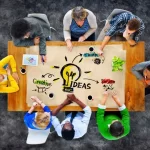The Power of Employee Recognition and Rewards: Fostering a Culture of Appreciation
In today’s competitive business landscape, attracting and retaining top talent is crucial for the success of any organization. While fair compensation and benefits are essential, companies that go the extra mile by implementing robust employee recognition and rewards programs are reaping the benefits of a highly engaged and motivated workforce. In this blog post, we’ll explore the significance of employee recognition and rewards, how they impact organizational culture, and some effective strategies to implement in your own workplace.
The Importance of Employee Recognition: Recognition is a fundamental human need that goes beyond monetary rewards. When employees feel valued and appreciated, they develop a sense of belonging, motivation, and job satisfaction. Recognition reinforces positive behaviors, boosts morale, and strengthens the emotional bond between employees and the organization.
It also helps create a culture of trust and transparency, fostering a supportive work environment where individuals are more likely to give their best effort. Types of Employee Recognition: Recognition can take various forms, and it’s essential to have a mix of strategies to cater to different employee preferences. Some popular approaches include: a) Verbal and Written Recognition: Simple yet powerful, expressing appreciation through thank-you notes, public acknowledgments, or team meetings can have a significant impact. b) Peer-to-Peer Recognition: Encouraging employees to recognize and celebrate their colleagues’ achievements fosters a sense of camaraderie and teamwork. c) Formal Awards and Incentives: Recognizing exceptional performance through awards, certificates, or bonuses adds a tangible element to the recognition process, providing a sense of accomplishment. d) Professional Development Opportunities: Offering opportunities for skill-building, training programs, or career advancement is a valuable way to recognize and invest in employee growth.
Designing an Effective Rewards Program: a) Personalization: Tailor your recognition efforts to align with individual preferences and aspirations. What motivates one employee might not resonate with another. Understand your employees’ needs and customize your recognition and rewards accordingly. b) Timeliness: Recognize and reward employees promptly after their achievements to maximize the impact and reinforce positive behaviors.
Delays can diminish the perceived value of recognition. c) Consistency: Establish a consistent system of recognition and rewards, ensuring fairness and avoiding favoritism. Create clear criteria and guidelines, making the process transparent and inclusive. d) Continuous Feedback: Regularly provide feedback to employees, both for positive performance and areas of improvement. Constructive feedback helps employees grow, while positive feedback boosts morale and motivation. Leveraging Technology for Employee Recognition: Technology can greatly enhance the efficiency and reach of your recognition and rewards program.
Consider adopting digital platforms or tools that facilitate peer-to-peer recognition, provide a centralized hub for tracking achievements, and offer seamless communication channels for sharing success stories across the organization. Measuring the Impact: To ensure the effectiveness of your recognition and rewards program, establish measurable goals and track key metrics. Employee engagement surveys, turnover rates, productivity levels, and performance appraisals can provide valuable insights into the program’s impact and identify areas for improvement.
Employee recognition and rewards are not mere gestures; they are powerful tools that drive employee engagement, enhance organizational culture, and boost overall performance. By cultivating a culture of appreciation, organizations create an environment where employees feel valued, motivated, and empowered. Implementing a well-designed recognition and rewards program demonstrates a commitment to the well-being and development of your workforce, leading to increased loyalty, productivity, and a sustainable competitive advantage in today’s dynamic business world.

































